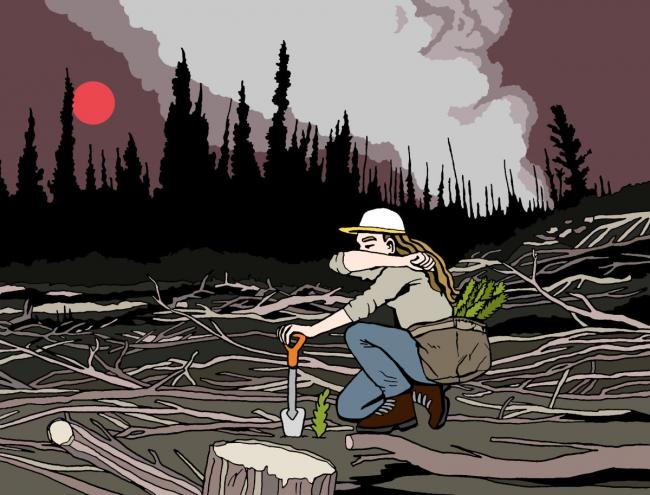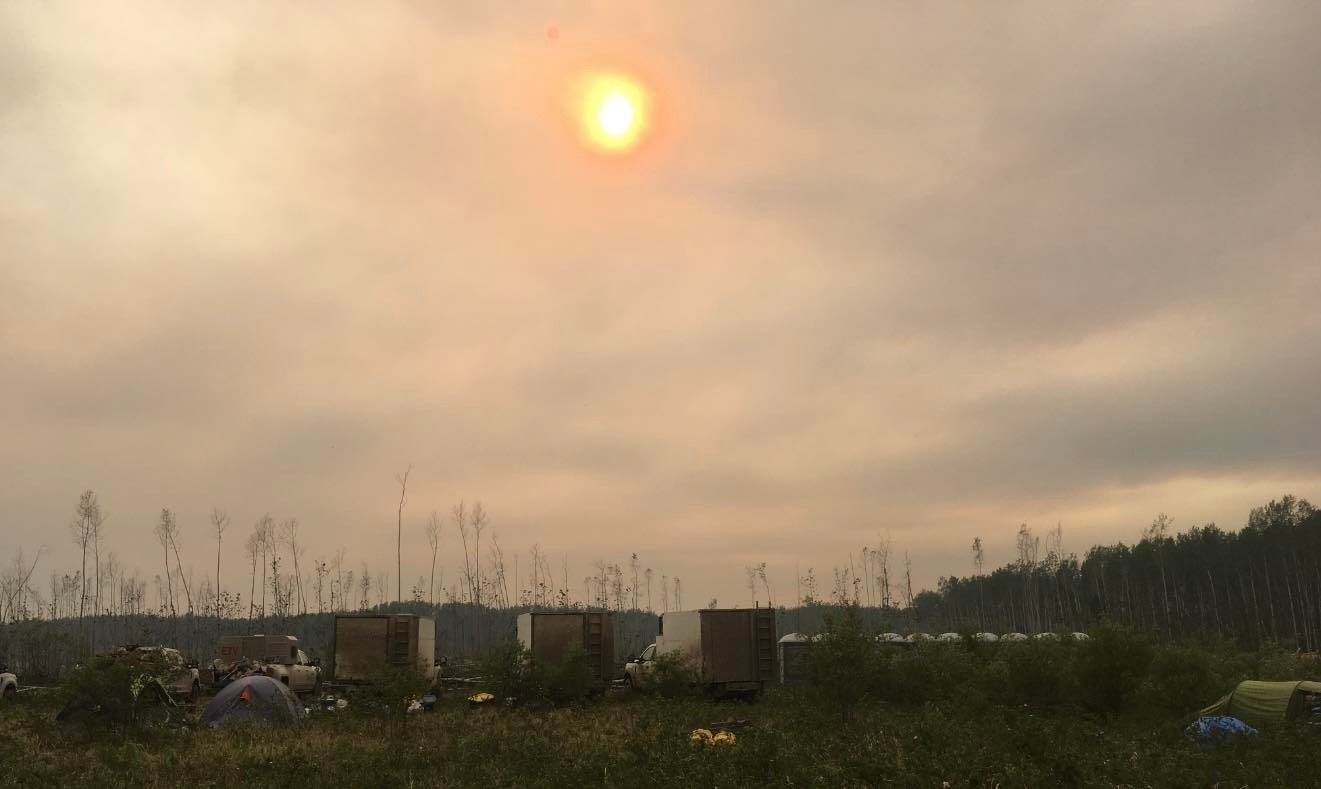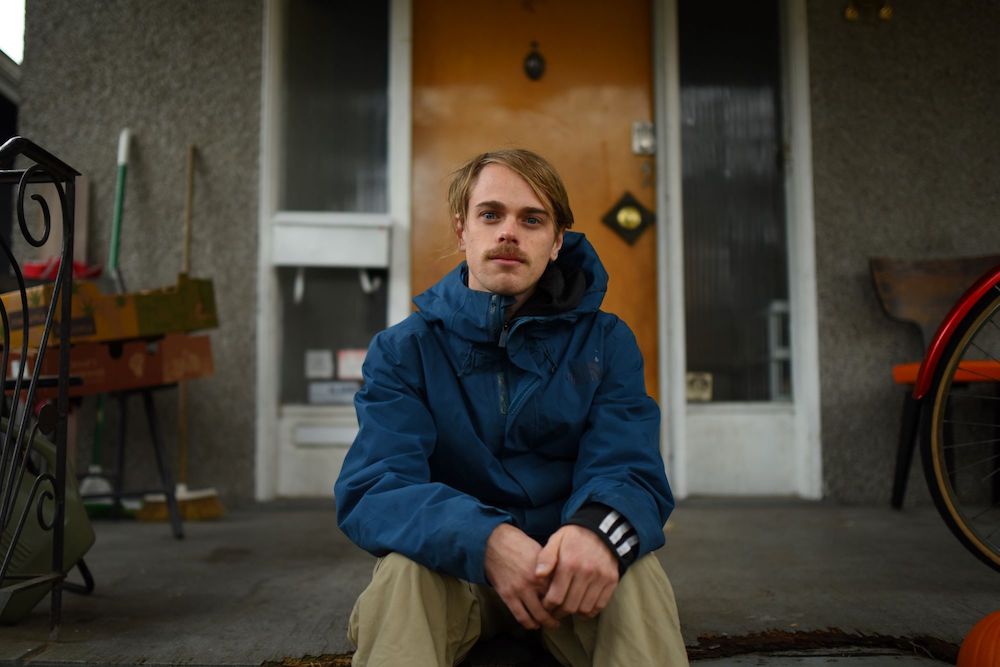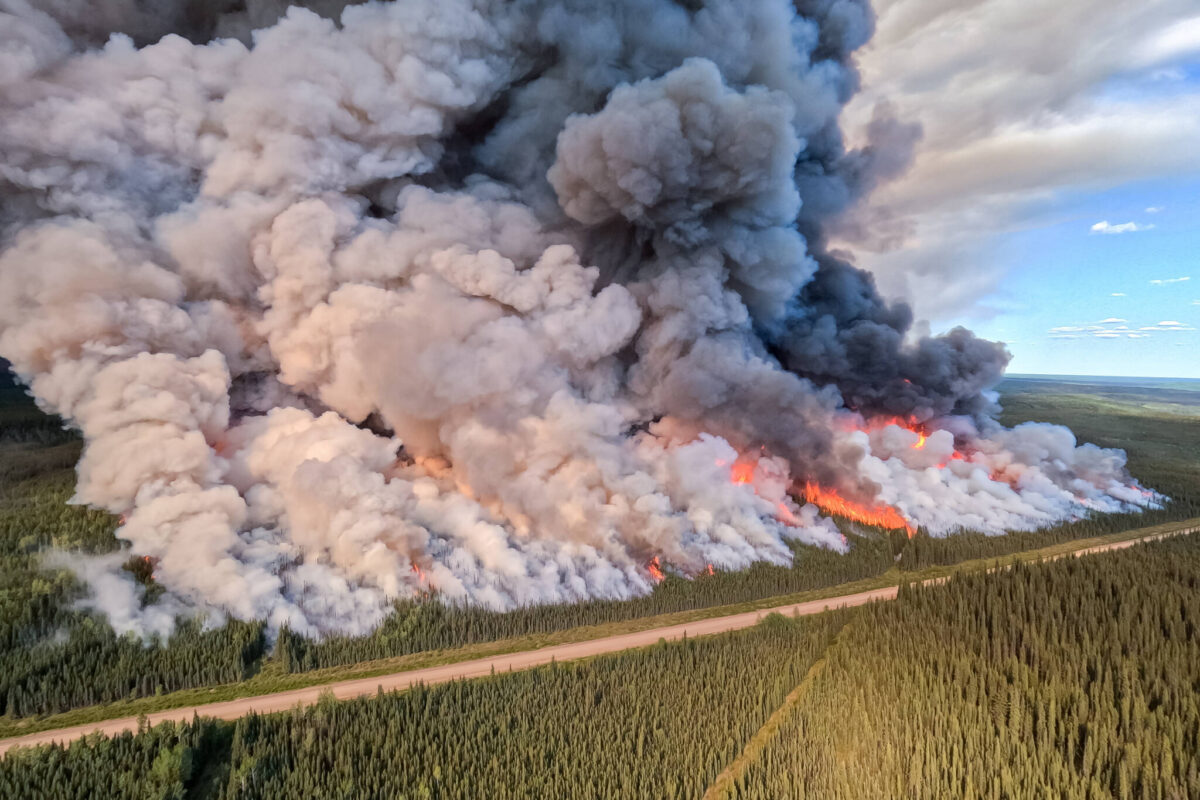Articles Menu

Sept. 18, 2023
Athick grey haze brewed above Alberta’s Slave Lake region in the summer of 2021. Seth Forward thrust his shovel into the earth to carve a home for green-needled seedlings. The heat and swarms of horseflies plagued him. But as Forward planted tree after tree, he was more concerned with the dark sky and acrid smell in the air.
“It was pretty much a summer of drowning smoke,” says Forward in an interview with the Climate Disaster Project’s Nicholas Naylor.
Still, his crew maintained their daily routine of rising from their tents at 5:30 a.m. under a haunting red sun. Forward pulled thousands of seedlings from his bags, mindful that nearby trees were blackened in fires, and worried by the smoke he and other planters were forced to breathe.
This summer’s worst recorded fire season in Alberta, British Columbia and across Canada means many more tree planters have been exposed to harmful pollutants contained within smoke.
But an investigation by the Climate Disaster Project and The Tyee reveals regulations in place for outdoor workers during Canada’s wildfire seasons haven’t done enough to protect those like Forward.
Silviculture safety and wildfire experts are calling on the provinces and territories to create work safety regulations specific to wildfire smoke that include monitoring air quality and introducing clear and enforceable measures to reduce exposure.
But WorkSafeBC, the safety regulator in the province that plants the most trees, says it has no plans to introduce specific wildfire smoke protections.
The job hazard is almost certain to grow. As a result of climate change, Canada has witnessed a trend towards more extreme fire weather brought about by prolonged periods of drought and extreme heat that leave trees and grasses dry — perfect conditions to fuel longer and more intense wildfires.
Forest management practices that suppress fire have made the problem worse. Now, when wildfires begin in these fire suppressed areas, surplus fuel creates larger and smokier fires.
“Tree planters are going to be planting in smokier and smokier conditions into the climate future,” says Sarah Henderson, scientific director of environmental health services at the BC Centre for Disease Control.
And if the ranks of tree planters swell to meet the federal government’s aim to plant more than two billion trees to fight climate change, they may be exposed to health risks arising from the very devastation they’re working to prevent.
‘I think it’s done permanent damage’
Tree planters in B.C., Alberta and Quebec plant more seedlings per year than all other provinces and territories combined.
In Quebec, Louis Bégin, president of Fédération de l’Industrie Manufacturière, which represents 250 unions including the national silviculture union, says burns were so severe this summer that many forestry workers were kept out of the bush entirely.
When asked about the threat wildfire smoke posed to those workers, he said, “When the next year comes, I’m sure this problem will come to Quebec.”
When it does, tree planters in that province could experience the same health risks as Forward, who says, “The smoke wasn’t good on the lungs.”
He adds, “It felt like I was smoking twice as many cigarettes as I was.”
Smoking is common in tree planter camps, says Forward. He puffs about a half pack a day while planting, and much less during the off season. Though he’d planted and smoked before, he’d never noticed any issues with his lungs until the wildfire smoke exposure.
Yet when Forward returned home in 2021, his sinuses wouldn’t stop running and his breathing was laboured and wheezy. His mother encouraged him to go see a doctor and he was diagnosed with asthma. While Forward can’t be sure, he suspects the smoke is at fault.
“I can’t see anything else other than the wildfire [smoke] being the main cause,” says Forward. “I think it’s done permanent damage.”
While research on long-term effects of wildfire smoke is in its infancy, early findings are worrying.
“We know enough to know we should be protecting people,” says Fay Johnston, head of the environmental health research group at the Menzies Institute for Medical Research in Australia, where smoke from bushfires has also affected millions of people.
The composition of wildfire smoke is a complex mixture of potentially toxic substances that varies with every burn. It can contain hazardous gases such as carbon monoxide, air pollutants such as benzene and heavy metals, and particle pollution.
Fine particulate matter, or PM2.5, a key component of wildfire smoke that causes adverse health effects, is often used to represent this complex mix for studies, says Johnston. And it’s what the Canadian Air Quality Health Index uses to assess air quality during smoke events.
These particulates are small enough to pass through the upper respiratory tract and deep into the lungs, and the smallest can even enter the bloodstream. This can trigger inflammation, respiratory issues, and even impair the function of other organs.
These minute particles are especially prevalent in wildfire smoke, says Johnston. “When wood fuels burn, you get a very high proportion of the really small size classes. The smaller the particle, the greater opportunity for health effects.”

Johnston’s own research on the effects of the 2014 Hazelwood coal mine fire in Australia that burned continuously for six weeks tells her that a few weeks of smoke exposure can have lasting effects. A study assessing the coal mine fire found exposure to its smoke in nearby towns decreased lung mechanics up to four years later.
Because coal mine fire smoke and wildfire smoke are similar in composition, “it’s reasonable to extrapolate to wildfire smoke,” says Johnston. “It’s a very similar exposure.”
Wildfire smoke also emits cancer-causing pollutants. A 2022 Canadian study conducted at the Quebec Interuniversity Centre for Social Statistics found that being exposed to a wildfire within a 50 kilometre radius of one’s residence was associated with a 4.9 per cent higher incidence of lung cancer and a 10 per cent higher incidence of brain tumours.
“All indications are that we do have to worry about longer term health detriments associated with shorter term smoke exposures,” says Henderson. “What I always tell people is if you protect yourself in the short term, you protect yourself in the long term.”
Despite these dangers, the only days Forward and his crew didn’t plant during that smoky summer in 2021 was when the helicopter used to transport them couldn’t safely take off because of visibility.
The planting season was extended to make up for the days of lost work.
A culture of ‘pushing through’
The ground was still smouldering when Claire Kuzmyk arrived in High Level, Alberta for her 2019 planting season. At her camp, Kuzmyk recalls only seeing blue sky a couple of times for her entire season.
“We spent a lot of it outrunning the fires,” says Kuzmyk, whose planting location and plans frequently changed based on where the winds were blowing and the fires burning. But there was no outrunning the smoke.
“It’s just grey in every direction,” says Kuzmyk, describing the daily helicopter rides to the planting blocks she was working in. “There’s not a single feature that you can see except maybe the top of one tree as we get too close to it.”
Later in Kuzmyk’s season, their planting camp also became a staging camp for wildfire firefighters.
“There were so many dragonflies everywhere,” recalls Kuzmyk, referring to the aircraft operating in their camp. “It felt like a war zone. They would literally be flying in and out of camp for like 14 hours of the day.”
That proximity to wildfires and denser smoke puts tree planters at increased risk, says Henderson. So does the physicality of their work, by increasing their breathing rate and therefore the amount of smoke they inhale.
And in most settings, there’s no escape. “If they’re in a tent camp, they don’t even have a safe place with filtered air to take shelter indoors,” says Jordan Tesluk, forestry safety advocate and auditor for the BC Forest Safety Council, a not-for-profit that focuses on the health and safety of forestry workers. “To me it’s beyond debate as to whether or not workers are at higher risk.”
For Avery Krahn, these risks became real when she was planting in Manning, Alberta in 2021. Krahn can remember the sun turning orange and the columns of smoke in the sky.
“The skies were grey, so I thought it was cloudy out, but it was just the smoke,” says Krahn. “It was like that for months.” As the fires got worse, the smoke grew heavier. One morning, upon arriving at her planting location, Krahn felt ill.
“It was really hard to breathe,” she says. Having a history of smoke sickness, she was afraid of passing out while alone in the bush. “We don’t have walkie talkies so no one’s coming to check up on you. Sometimes I’ll go 10 hours without seeing someone.”
Krahn said that she wouldn’t be working for the day. In industry terms, she was refusing unsafe work, a right that all tree planters have.
“They made fun of me all day, saying I was weak,” says Krahn.
In tree planting there’s a culture of “pushing through to a toxic degree,” says Billy Pattersen, co-operative developer for Tree Workers Industrial Group, a silviculture workers advocacy group. This can make it difficult for those who want to enact different boundaries. Especially when there aren’t any specific regulations in place to protect outdoor workers from wildfire smoke in Canada.
“It’s something that, honestly, I can say we haven’t dealt with adequately,” said Tesluk.
Few specific legal protections
Though there are no wildfire-specific protections in Canada, each jurisdiction has general occupational safety regulations that would apply to smoke. Employers are expected to treat wildfire smoke as a general hazard and must ensure the safety of their employees. However, there are no specific regulations as to how to do this or at what point wildfire smoke becomes an undue risk.

While Canadian jurisdictions have exposure limits for many hazardous compounds — including some found in wildfire smoke such as toxic gases — they do not have exposure limits for PM2.5, the wildfire smoke component “of greatest health concern,” according to the United States Environmental Protection Agency.
Of the three provinces where the most Canadian tree planting takes place, the closest thing to a PM2.5 threshold is a catch-all exposure limit that each province has designed for dust particles not otherwise listed in their provincial exposure tables. This includes one for respirable particulate (particles small enough to reach the lungs, which could be up to 10 microns in diameter, or PM10).
Alberta’s exposure limit table requires that exposure to respirable particles be kept below 3 milligrams per metre cubed for an eight-hour day.
B.C. follows the American Conference of Governmental Industrial Hygienists limit, which is the same as Alberta’s, except it recommends rather than requires that exposure to be kept below 3 mg/m³ for an eight-hour day.
Quebec has no set exposure limits specifically for otherwise unclassified respirable particles but have a larger category for all other unclassified particles that can’t exceed 10 mg/m³ for an eight-hour day.
By comparison, the World Health Organization’s air quality guidelines set the limit for respirable particles at an average of 45 micrograms per metre cubed over 24 hours. They recommend only exceeding this limit three to four times a year. That’s 66 times less than the Canadian limits.
These regulations were “designed for masons and stone cutters, and then people wearing PPE,” says Johnston. “They weren’t written thinking about outdoor workers and bushfire smoke.”
While they don’t have specific regulations regarding wildfire smoke, B.C., Alberta and Quebec all have brochures outlining the risk of that smoke and some precautionary measures that may be taken. Since the Climate Disaster Project first reached out to WorkSafeBC in May, the agency also released a statement during the severe wildfire smoke in August urging employers to protect workers and monitor the air quality index.
The Commission for Standards, Equity, Health and Safety at Work, or CNESST, the organization responsible for Quebec’s labour rights and obligations, released a similar statement in June. A spokesperson for CNESST says its recommendations to “limit exposure to airborne contaminants are in line with those of other ministries and agencies.”
Beyond provincial and territorial regulations, the silviculture industry in Western Canada has many of its own best practices, says Tesluk. These are safety routines that are not enforced by the government but have become common practice, although they can vary across companies.
Windstorm safety practices provide a precedent for how these measures can develop.
Tree planters sometimes plant around “danger trees” — lone trees left standing by loggers and increasingly weakened by wildfires — that are liable to topple in high winds. Prior to 2020, there were limited protections for this situation.
“A big gust of wind would come through, and you’d hear two or three trees come down in your piece while you’re planting,” says Kuzmyk. “There were some close calls.”
“We all knew that eventually a tree was going to fall down and kill somebody,” says Tesluk.
Eventually, one did. In the camp across the road from Kuzmyk, a 23-year-old woman from Quebec was killed when a danger tree fell in her block. As a result of her death, the silviculture companies implemented wind thresholds that give planters the opportunity to stop working in high winds. Tesluk says this practice is now included in training resources and most company programs.
“When it comes to chronic [smoke] exposure, we don’t have one of those events to spur action,” says Tesluk. “It’s not like a mountain of wildfire smoke is going to incinerate somebody to death. Wildfire is insidious. It’s gonna make you pay down the line.”
Windstorms aren’t the only hazard the industry has best practices for, says Tesluk.
“If you have any sort of massive wildfire within sight of your operation, you get out of there,” says Tesluk. “You have an aggressive animal, you have to stop working and get out of there. We even have a rainfall threshold.”
They also have standards for shutting down during nearby lightning strikes. But there is no industry standard for wildfire smoke, although North Vancouver-based tree planting company Zanzibar introduced safety measures in July based on PM2.5 levels, including the option of not working, providing masks, and shutting down operations at extremely high levels.
A call for regulatory action
Henderson says she’d love to see B.C. “start leading the national conversation about how we’re going to protect workers from wildfire smoke.”
Tesluk says that if WorkSafeBC took action on implementing specific protections and protocols, it would be a crucial step towards recognizing wildfire exposure as a workplace hazard.
“WorkSafe is notorious for giving some sort of vague directive but never wanting to put a real clear standard of what an unsafe condition is,” says Tesluk. “Their hands off approach is weak on their part as an institution.”

When the Climate Disaster Project contacted WorkSafeBC, a spokesperson confirmed they are aware of the health risks associated with wildfire smoke but that there is no current plan to revise the regulations to include smoke exposure.
A spokesperson for B.C.’s labour minister, Harry Bains, declined a request for an interview.
Alberta’s minister of jobs, economy and trade did not respond to requests for comment.
A spokesperson for Quebec’s labour minister responded that the CNESST engages in prevention work to raise awareness of risks to forestry workers such as heat stroke, wildfires and smoke plumes.
By comparison, jurisdictions in the United States have put in place specific regulations in the wake of recently worsening wildfire seasons.
Regulations in California and Oregon now require employers to monitor air quality during wildfire smoke events and limit exposure at certain thresholds. Employers are also required to supply respirators for voluntary use when the air quality index for PM2.5 reaches at least 101 in Oregon, and 151 in California.
Respirators are deemed mandatory for workers once the AQI reaches 251 in Oregon and 500 in California. And employers are required to include wildfire smoke safety training in advance of smoke events, and, when possible, reduce exposure through measures such as relocating workers or shifting work schedules.
While these safety regulations are more advanced than any in Canada, Johnston still feels they aren’t adequate to protect tree planters.
“We know there’s no safe lower level of air pollution,” says Johnston. “A lot of the impacts on your health happen before those [thresholds].”
She feels these regulations are only good for short-term events. Johnston wants to see regulations designed for prolonged smoke exposure.
“As every day goes by, you’ve got to get more conservative,” says Johnston. “By the time you’re getting to two or three weeks, you’re talking about harm beyond the season of working.”
For workers with pre-existing health conditions, such as asthma or cardiovascular disease, that are more severely impacted by smoke, Johnston thinks the thresholds should be lower than for the general public.
Yet both researchers feel the U.S. regulations are a step in the right direction. “My overwhelming reaction is good on them, because they’re trying really hard,” says Johnston.
Henderson notes that even if regulations are in place, they can be difficult to enforce.
“Personally I would not plant while wearing a mask,” says Krahn, for example. “I can’t deal with heat.”
Tesluk says making tree planters wear currently required PPE is already a challenge; masks likely would be no different. “The moment anybody’s paid on commission, you’re gonna have compliance issues,” says Tesluk.
Given how physically demanding their work is, masks may not even be an effective measure of protection. Sweat could saturate an N95 respirator and limit its ability to filter out harmful particles, says Henderson.
Changing the rules of tree planting
The structure of the silviculture industry poses another barrier to enforcement of wildfire safety measures. Contractors bid on planting contracts in the winter, often pricing their services low to beat the competition. When planting season comes around, they have contractual deadlines to meet and limited financial protections if they give workers days off for safety.
Even the workers themselves feel the financial pressure, says Tesluk. If they don’t work, they don’t get paid. And if they work faster, they get paid more.
“The way it’s set up, there’s an incentive for people to subject themselves to conditions that they would not normally otherwise subject themselves to,” says Tesluk.
He suggests eliminating that incentive by reducing workload on smoky days and providing tree planters with a day rate.
Tesluk also would like to see wildfire smoke safety measures be written into the planting contracts so employers have the financial backing from licensees to remove workers from wildfire smoke risk.
However, ultimately, when it comes to wildfire smoke protection, the best defence is exposure reduction. To do this, the industry could have similar stop work orders to those that exist for wind. When winds are greater than 40 kilometres per hour, planters are required to leave their cut blocks. Kuzmyk says when this happens planters at her company are still paid based on their average planting rate, but according to Tesluk this isn’t industry standard.
“I could see us monitoring air quality in a similar manner in the future,” says Pattersen. “Once it’s unsafe to breathe, we have to leave.”
Henderson suggests shifting the planting hours to earlier in the morning, because wildfires damp down at night and peak around noon. A practice like this, known as “fire hours,” already exists for extreme heat to keep workers from overexerting themselves.
But Tesluk doesn’t think shifting hours would work, because “the smoke is always there. It’s really hard to predict. You never know what elevation you’re going to be working at or what part of the valley.”
Another possible solution is to provide breaks in clean air spaces such as hotels. That’s because breaks from the smoke could decrease the health effects of their exposure, says Henderson.
But Tesluk warns that providing hotel rooms for planting crews would be difficult, especially on short notice. There are already limited housing options in communities tree planters work near and, in the event of smoke, hotels fill up with wildfire refugees.
Solutions may not be simple, but Tesluk, Johnston and Henderson feel regulation is paramount. Without any clear or specific standards in place to protect them, planters will continue inhaling gases and fine particles while they plant thousands of trees.
“Looking back on it, I would not have worked outside for that long during those times,” says Forward of his days planting in wildfire smoke. “It’s easy to feel cheated when you’re not given all the information.
Aldyn Chwelos, Kristen de Jager and Paul Voll are part of the Climate Disaster Project.
[Top: ‘We shouldn’t be working in this.’ Tree planters say that industry pressures trap them in unsafely polluted settings. Illustration by Nora Kelly.]